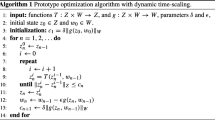Abstract
Direct transcription methods for the numerical solution of optimal control problems have the advantage that they do not require estimates of the adjoint variables. However, it is natural to want to use the discrete NLP multipliers to estimate the adjoint variables. It has been shown earlier in the literature for a large collection of numerical discretizations that order of the state and control variables found are generally independent of the implementation of the chosen discretization if no post processing is used to find the control. This is not always true for the adjoint estimation problem. The compressed trapezoidal discretization is used in some commercial codes. In this paper we show that the second order adjoint estimate result for the uncompressed trapezoidal method does not hold for the compressed trapezoidal method. We also show how to recover the lost order and carefully analyze convergence. Some related results are also discussed.
Similar content being viewed by others
References
Alber M, Birkner M, Nüsslin F (2002) Tools for the analysis of dose optimization: II, sensitivity analysis. Phys Med Biol 47:N265–N270
Betts J (2001) Practical methods for optimal control using nonlinear programming. SIAM, Philadelphia
Betts J, Huffman W (2004) Estimating adjoint variables from a direct transcription solution. Technical report, Phantom Works, Mathematical and Computing Technology, Seattle, WA
Betts J, Carter M, Huffman W (1997) Software for nonlinear optimization. Technical report, Boeing Information and Support Services
Borggaard J, Vance J (2004) Sensitivity equations for the design of control systems. In: Hamza M (ed) Proceedings of control and applications (CA 2004), Marina Del Rey, CA, USA, p 441
Dontchev A, Hager W, Poore A, Yang B (1995) Optimality, stability and convergence in nonlinear control. Appl Math Optim 31:297–326
Dontchev A, Hager W, Veliov V (2000) Second-order Runge-Kutta approximations in control constrained optimal control. SIAM J Numer Anal 38:202–226
Engelsone A (2006) Direct transcription methods in optimal control: theory and practice. PhD thesis, Operations Research Program, North Carolina State University. Downloadable from http://www.lib.ncsu.edu/etd/
Engelsone A, Campbell S, Betts J (2005) Order of convergence in the direct transcription solution of optimal control problems. In: Proceedings of the IEEE conference decision control—European control conference, Seville, Spain
Fahroo F, Ross I (2001) Costate estimation by a Legendre pseudospectral method. J Guid Control Dyn 24(2):270–277
Hager W (1976) Rates of convergence for discrete approximations to unconstrained control problems. SIAM J Numer Anal 13:321–338
Hager W (2000) Runge-Kutta methods in optimal control and the transformed adjoint system. Numer Math 87:247–282
Hairer E, Wanner G (1991) Solving ordinary differential equations, II: stiff and differential-algebraic problems. Springer series in computational mathematics, vol 14. Springer, Berlin
Hairer E, Norsett S, Wanner G (1993) Solving ordinary differential equations, I: nonstiff problems. Springer series in computational mathematics, vol 8. Springer, Berlin
Lempio F, Maurer H (1980) Differential stability in infinite-dimensional nonlinear programming. Appl Math Optim 6:139–152
Lucet Y, Ye J (2001) Sensitivity analysis of the value function for optimization problems with variational inequality constraints. SIAM J Control Optim 40(3):699–723
Malanowski K, Maurer H (1996) Sensitivity analysis for parametric optimal control problems with control-state constraints. Comput Optim Appl 5:253–283
von Stryk O (1993) Numerical solution of optimal control problems by direct collocation. In: International series of numerical mathematics, vol 111. Birkhäuser, Basel, pp 129–143
Author information
Authors and Affiliations
Corresponding author
Additional information
Research supported in part by NSF Grant Number DMS-0404842.
Rights and permissions
About this article
Cite this article
Engelsone, A., Campbell, S.L. Adjoint estimation using direct transcription multipliers: compressed trapezoidal method. Optim Eng 9, 291–305 (2008). https://doi.org/10.1007/s11081-008-9038-2
Received:
Accepted:
Published:
Issue Date:
DOI: https://doi.org/10.1007/s11081-008-9038-2




